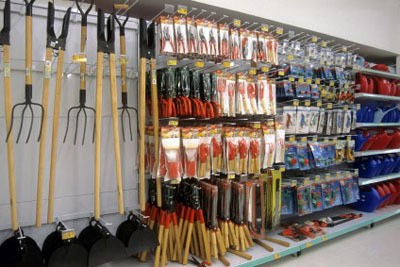
Buying new or replacement garden tools can be a sizeable, but necessary, investment. Here are some tips for choosing high-quality, long-lasting tools so you know you are getting the most value for your money.
When purchasing garden tools, it almost always better to buy the highest quality you can afford - even if it seems expensive at the time. Well-designed tools made from quality materials will only save you time and money in the long run. The exception to this may be pruners. Buying an expensive pair of pruners isn't as important as buying a pair that can be disassembled easily for cleaning and sharpening.
When shopping for tools, it's important to read labels and understand manufacturer claims:
Forged or drop-forged: This term means the blade or head has been formed by mechanically hammering or pressing a hot metals into dies. Forging improves the strength of the metal by aligning and stretching the grain structure and produces a stronger, better balanced tool than pressed or machine formed tools.
Gauge: This refers to the overall thickness of the metal head or blade. The lower the gauge number, the thicker the steel and the less likely the blade or head will break due to heavy use. Thicker gauge metal is also easier to sharpen.
Heat-treated or tempered: This indicates that the steel use to make the tool has undergone a re-heating process, which creates a tougher and less brittle head or blade. Tempered metal is usually easier to sharpen and will stay sharp longer.
High-carbon steel: A very strong steel in which the main alloying constituent is carbon. Tools made from high-carbon steel are very hard, wear-resistant, and able to take a sharp edge.
Solid hardwood handle: A good hardwood handle offers more flexibility and less vibration and cold transfer than a metal or fiberglass handle, but not all "hardwoods" are created equal. If you're looking for a wooden handle that will last, choose white ash or hickory. Make sure it's straight and knot-free. Also check to see how the head or blade of the garden tool is the attached to the handle.
Stainless steel: These garden tools tend to be more expensive, because they are extremely resistant to corrosion and rust. Look for tempered steel for added flexibility.Stamped: This refers to a tool made from a piece of sheet metal has been cut or punched and then bent (formed) using a machine press or stamping press. Tools made this way are usually lightweight and inexpensive, but also weaker and much less durable.
In addition to considering how they will be used - sitting, kneeling, or standing - it's important to choose tools that match your height and strength. Tools with longer handles will provide you with the greatest amount of leverage and reach, but require more arm strength. Tools with shorter handles give you greater flexibility and maneuverability in tight spaces, but require greater leg strength.
Many people assume that gardening hand tools are designed to be ambidextrous - meaning they may be used equally well with either hand. Of course, most of the people that assume this are also right-handed. If you're a left-handed gardener, trying to perform a simple garden task using a tool designed for right-handed people can be incredibly frustrating - and at times, even dangerous. Although they are typically harder to find, many weeders, hoes, pruners, and trowels are now available in both right and left-handed models.
All other design features being equal, if you have the choice, always go for tools with padded handles and an ergonomic design. These tools are specially designed to minimize sore wrists and help prevent blisters. If you want to make the tools you're currently using more comfortable, try adding cushion to your handles using pieces of pipe insulation.
Have you ever set one of your garden tools down for minute while performing another task only to spend the next 5 minutes wandering around trying to find it again? Yeah. Me too. Those yellow pruners and electric green trowels you see on store shelves lately are meant to be an eyesore. Brightly colored tools are easier to spot against black dirt and green foliage.

About The Author: Ellen Brown is an environmental writer and photographer and the owner of Sustainable Media, an environmental media company that specializes in helping businesses and organizations promote eco-friendly products and services.
Add your voice! Click below to comment. ThriftyFun is powered by your wisdom!